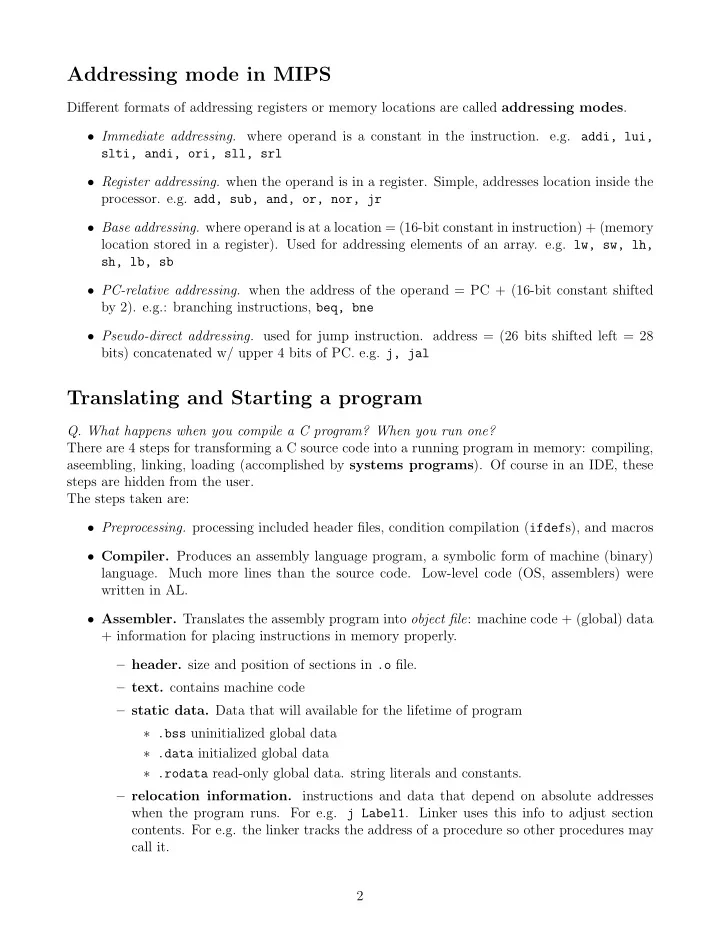

Addressing mode in MIPS Different formats of addressing registers or memory locations are called addressing modes . • Immediate addressing. where operand is a constant in the instruction. e.g. addi, lui, slti, andi, ori, sll, srl • Register addressing. when the operand is in a register. Simple, addresses location inside the processor. e.g. add, sub, and, or, nor, jr • Base addressing. where operand is at a location = (16-bit constant in instruction) + (memory location stored in a register). Used for addressing elements of an array. e.g. lw, sw, lh, sh, lb, sb • PC-relative addressing. when the address of the operand = PC + (16-bit constant shifted by 2). e.g.: branching instructions, beq, bne • Pseudo-direct addressing. used for jump instruction. address = (26 bits shifted left = 28 bits) concatenated w/ upper 4 bits of PC. e.g. j, jal Translating and Starting a program Q. What happens when you compile a C program? When you run one? There are 4 steps for transforming a C source code into a running program in memory: compiling, aseembling, linking, loading (accomplished by systems programs ). Of course in an IDE, these steps are hidden from the user. The steps taken are: • Preprocessing. processing included header files, condition compilation ( ifdef s), and macros • Compiler. Produces an assembly language program, a symbolic form of machine (binary) language. Much more lines than the source code. Low-level code (OS, assemblers) were written in AL. • Assembler. Translates the assembly program into object file : machine code + (global) data + information for placing instructions in memory properly. – header. size and position of sections in .o file. – text. contains machine code – static data. Data that will available for the lifetime of program ∗ .bss uninitialized global data ∗ .data initialized global data ∗ .rodata read-only global data. string literals and constants. – relocation information. instructions and data that depend on absolute addresses when the program runs. For e.g. j Label1 . Linker uses this info to adjust section contents. For e.g. the linker tracks the address of a procedure so other procedures may call it. 2
Figure 1: Steps for translating a C program Figure 2: Linking the objects files 3
Figure 3: Use of relocation records – symbol table. tracks labels. set of label symbols and their addresses. Since assembler needs to remove traces of all labels. – debugging information. description of how code was compiled Assembler also provides pseudoinstructions to make things easy for assembly code writer. For e.g. move $t0, $t1 is a p-instruction that is translated as add $t0, $zero, $t1 . Sim- ilarly, blt is translated into slt and bne , and so on. Assembler reserves register $at for its own purposes like these. • Linker. Stitches all independent assembled, machine language programs into one. – Changing one line of code would require recompilation. – obvious for personal code. Very wasteful for libraries , since they never change. – Better: ∗ Compile & assemble code separately so recompilation is contained – Linker also allows us to develop libraries in isolation – Three steps in linking ∗ place code and data in memory symbolically ∗ determine addresses of data and instruction labels ∗ patch internal and external references – Uses relocation info and symbol table in each .o module to resolve undefined labels – produces an executable file w/ same format as .o file but with no unresolved references. – Statically linked vs. dynamically linked 4
∗ with static approach: can be using old linked library; size issues • Loader. Loads the executable in memory to start it – reads size of text and data segments – creates address space for them and copies them to the created space – copies arguments for main to the stack – initializes registers (sets to 0) sets SP to 1st free location on stack – calls a start-up routine that copies args to arg registers and calls the main routine. 5
Recommend
More recommend